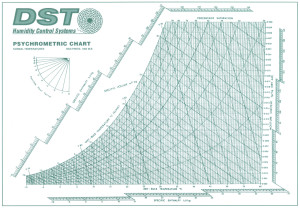7 step Selection method is described below to realise the Advantages described as follows
Benefits of DOAS Dedicated Outdoor Air Dehumidification
- Reduce Energy
- Improve IAQ
- Independent T & RH control
- Reduce air-conditioning kWR
- Reduce ducting and plant size
- 10% chiller capacity & η gain
- Solar, DX, CHW, ERV options
Benefits
Improved IAQ Generally maintaining surface humidity below 60%rh will maintain a neutral mould and bacterial growth rate. Humidity control impact to buildings is acknowledged by the following relevant standard. ASHRAEs design window between 40-60%rh, and a designated energy modelling parameter of 65%rh by ASHRAE 62.1-2007(5.10.1). Japans’ sanitation law of 40%-65%rh is supported with efficient building standard CASBEE with credits for 55%rh to 45%. Australia’s Green Star also credits below 60%rh in space and 80%rh in duct. Humidity induced problems can occur in typical building design practices that ignore the substantial ”part load” hours when little cooling is required but humidity is still considerable.
Better Temperature & RH Control The effect of a preconditioned desiccant can dry the fresh air to below 5Cdp (or 30%rh at 23°C) and 11-14°C temperature increase when regenerated with 50-60°C. And need less preconditioning when reactivated with 120°C. In central Air-conditioning systems, the sensible heat ratio (SHR) mismatch occurs when the outdoor %rh is high and neutral temperature. This is neutralised by having desiccants having the latent duty and a separate devices for sensible, providing independent control capacity.
Simply providing the room dew point doesn’t work as any internal load and infiltration forces the humidity over set point and over cool and reheat to be wasteful.
Reduced Air Conditioning Coil Work The design practice of DOAS with desiccants is now prominent with technology advancement and over 100,000 commercial buildings systems.(ref ASHRAE May 2008) DOAS avoid humidity problems and save energy by removing the latent load of outside air, and over drying the outdoor air sufficiently (ie 5°Cdp or 30%rh @ 23°C) to absorb the indoor (moisture) latent load. This avoids the cost of dehumidification of the entire recirculated air stream. The use of Exhaust Air in and Energy Recovery Ventilator ERV option also reduces this energy substantially.
Reheat Avoidance Reheating of overcooled air is a traditional low cost practice to allow air-conditioning plant to dehumidify to dewpoint (ie 12°C) and re-heat the air back towards room temperature. Part load conditions often see ventilation loads creating a need for dehumidification but little or no sensible cooling, so overcooling is becomes more wasteful. This practice was restricted in 1999 and later banned in USA by building energy standard ASHRAE90.1 and countries like Australia have banned the use of electric elements for reheat.
Reduced Plant Size, Increase COP DOAS allows the used of chilled beams and smaller more efficient plant. Due to the SHR being substantially different to that of what commercial air conditioning is designed for, the cooling plant is oversized to deal with the latent component. With standard operating temperature differences across cooling plant the recirculation airflow can be double what is needed. ie an operating scenario may have external latent load of 50kWR and internal latent of 50kWR, (ie 199kWRlat) and with total sensible of 100kWR a SHR of 0.5 results, where coils are often comfortably designed for 0.7. Commercial Buildings building have various configurations.. When assessing a design or refit for DOAS, the following considerations will influence the system selection.
- Minimum ventilations required (exhaust)?
- Exhaust air availability for use on ERV?
- Services such as chilled water, and COP Coefficient of performance? (ie kW input = kW refrigeration/COP)
- Hot water, gas to 50C or waste heat temp?
- Customer priority CO2 cost energy IAQ
SELECTION
Example. For 10,000m3/h Chilled water DOAS needs 5C off coil and a Desiccant-DOAS system requires 12C and 84kW Condenser heat/hot water to maintain 23C 50%rh assuming 7.5l/s and 60W person . This saves 130kWR and the increase in water temperature of 4-5C improves an air cooled chiller COP by 10%.
STEP1 Number of building occupants?
- Local codes have a minimum OA quantitiy
- USA 15cfm per person
- AUSTRALIA 7.5 l/s per person
- Eg 400people x 7.5l/s pp = 3000l/s (10000cmh)
STEP 2 OA design condition
Important to know for chille watger capacity check eg35CDB 24CWB
STEP 3 Room humidity ratio
- 50%rh 23C library 8.8g/kg
- 60%rh 23C commercial building
- 50%rh 23C (or other) Supermarket 8.8g/kg
- 60%rh at 28C swimming pool
STEP 4 People x nominal load
100g/h pp Eg 400 x 100g/h = 40kg/h NOTE 40kg/h x .683 = 28 kW latent
STEP 5 Internal infiltration rate
Best to make as extra consideration as as overdesign may occur in commercial projects. This can be data provided by consultant (design institute), including external ductwork 1% leakage rate or from customer on large systems, or some estimate based on DST How much OR Munters guide for small rooms
- Tight 0.1 cfm/ft2 A(8.8cmh/m2).
- Average 0.3 cfm/ft2(25cmh/m2)
- Loose 0.6 cfm/ft2 (50cmh/m2)
Moisture Load
Room 20 x 20 x 3 (A= 20×20=400m2) = cmh/m2 x m2 x 1.2 x Design day g/kg – Room g/kg
=8.8 x 400 x 1.2 x (14-8.8)/1000
=23kg/h (USA btu/hr= .68 x cfm/ft2 x (design day HR – space HR)
NOTE: DST how much selection factor 3 equated to 1200cmh
It is adviable to make selection based on moisture from people alone, if it is below
STEP 6 Calculate Humidity ration Δg/kg
Fresh air delivered this much dryer than room dewpoint
= internal load (Q4+Q5kg/h) / (OA m3/h x ρ kg/m3) x1000
= (40+23)/(10,000x 1.2) =5.25g/kg (NOTE 3.3g/kg on moisture from people alone)
STEP 7 : REQUIRED OA Supply HR g/kg
SA HR = Room HR(step3) – Δg/kg(step6)
ie Supermarket : SA HR= 8.8-3.5=5.3g/kg OR 4.5C dewpoint (Cant be done reliably by chilled water or DX alone.) Usually desiccant duty around 3.5g/kg so off pre cooling coil using desiccant 8.8g/kg or 12Cdp.
Desiccant dehumidification has had substantial application into commercial buildings in humid climates due to operating and compliance requirements of the case manufacturers, and the inability of conventional HVAC to dehumidify effectively



